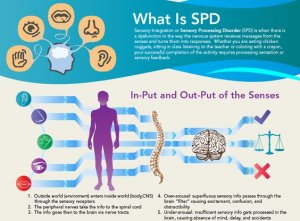
By: nspt4kids.com
Sensory processing dysfunction can affect a child or individual in a variety of ways. Normal functioning children can experience symptoms associated with sensory processing disorder(SPD), also known as sensory integration dysfunction (Sweet, 2010). In this disorder, the individual is not able to process sensory information that they receive in their senses (Sweet, 2010). This can correlate to difficulty with learning, developing behaviors, or decrease functional performance in their daily lives (Sweet, 2010). SPD is linked with Autism Spectrum Disorder, Attention Deficit Hyperactivity Disorder, Fragile X Syndrome, Down Syndrome, and other developmental or neurological disorders (Sweet, 2010).
Types of Sensory Dysfunction
Over Responsive:
- high energy
- impulsive
- aggressive
- overstimulated
Under Responsive:
- fearful
- anxious
- calm
- lazy
Sensory Avoidant:
- flat affect
- passive
- anti-social
Sensory Seeking:
- overexcited with stimuli
- impulsive
- risk taker
- loud
The videos below provides useful information regarding the specific signs and symptoms a child with sensory processing disorder or dysfunction may present with.
Treatment:
Professionals that can help children that are negatively affected by sensory processing issues include Psychologists, Occupational Therapists, Pediatricians, and School evaluators.
Treatment interventions include:
- Adapting the individuals environment to allow for child to focus or have an area where they can decompress.
- Utilize compensatory strategies to decrease negative behaviors and help the child cope with difficulties they have related to sensory processing.
- Educate caregiver and child about sensory strategies to help child compensate.
- Learn triggers and effective strategies child and family can use to address individual sensory issues.
Resources:
Dunstan E, & Griffiths S. (2008). Sensory strategies: practical support to empower families. New Zealand Journal of Occupational Therapy, 55(1), 5–13. Retrieved from http://search.ebscohost.com/login.aspx?direct=true &db=ccm&AN=105760656&site=ehost-live
Resources for Families. (n.d.). Retrieved January 25, 2020, from https://childmind.org/audience/for-families/
Sweet, M. (2010). Helping Children with Sensory Processing Disorders: The Role of Occupational Therapy. Odyssey: New Directions in Deaf Education, 11(1), 20–22.
